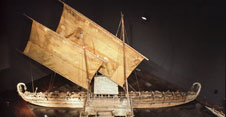Bereichsnavigation
Dahlem
When Germany was still divided, many of the museums in West Berlin were located in Dahlem. After reunification, a large number of collections were transferred to Mitte. In 2021 approximately 24,000 objects from the Ethnologisches Museum and the Museum für Asiatische Kunst moved to the Humboldt Forum. Dahlem has a new focus as a research campus and the museums’ storerooms, workshops, and libraries, along with the Museum Europäischer Kulturen. The SPK’s Institut für Museumsforschung and Geheimes Staatsarchiv Preußischer Kulturbesitz will also remain in Dahlem.
The Plans under the Empire: A “German Oxford” in Southwestern Berlin
Around the turn of the twentieth century, Dahlem was conceived as a location for the sciences. In the “German Oxford,” parts of the university, scientific institutions, museums, and other educational facilities would be located. Buildings were also constructed for several of the collections that now become to the Stiftung Preussischer Kulturbesitz (Prussian Cultural Heritage Foundation).
For the Völkerkundemuseum (now Ethnologisches Museum – Ethnological Museum), four new buildings were supposed to be constructed. By 1921, however, only one new building, based on plans by Bruno Paul, could be completed, and it was then used as storage or for the study collections. An archive building was also built in Dahlem for the former Preussisches Geheimes Staatsarchiv.
The Second World War and the dissolution of Prussia initially put an end to plans to build a site for science in southwestern Berlin. Only during the period of Germany’s division, following the foundation of the Freie Universität, was the idea picked up again.
Housing the Museum Collections after the Division of Berlin
The Bruno-Paul-Bau (Bruno Paul Building) was one of the few buildings available to the Foundation to house its collections when it was founded in 1957. In accordance with its first plan for the Foundation’s locations, the building was supplemented with a new building to house what was then known as the Museum für Völkerkunde and the departments of Asian art. The Foundation commissioned the architect Wils Ebert. In 1970 the first three departments of the Völkerkundemuseum and the Museum für Ostasiatische Kunst (Museum for East Asian Art) opened in the building, followed in 1971 by that portion of the collection of the Museum für Islamische Kunst (Museum of Islamic Art) that was located in West Berlin as well as the Museum für Indische Kunst (Museum for Indian Art). The Museum für Ostasiatische Kunst and the Museum für Indische Kunst have since been merged as the Museum für Asiatische Kunst.
In addition, several of the collections that would later move to new buildings at the Kulturforum were initially housed in Dahlem: The Sculpture Gallery, the Kupferstichkabinett (Museum of Prints and Drawings), and the Gemäldegalerie (Old Master Paintings). This “provisional” solution in Dahlem lasted longest for the Gemäldegalerie, which did not move until 1998. The bust of Nefertiti and the rest of the Egyptian collection were shown in the Bruno-Paul-Bau until being moved to Charlottenburg in 1967.
The Museum District in Dahlem after Reunification
When Berlin’s Staatliche Museen (National Museums) were reunited, the Foundation envisaged Dahlem as its center for non-European cultures. Once the rest of the collections of the Staatliche Museen were moved out, the Ethnologisches Museum and the Museum für Asiatische Kunst had more space in which to present their exhibitions. From 2019, the collections of both museums will be shown in the Humboldt Forum in Mitte.
The Museum Europäischer Kulturen was formed in 1999 from the part of the Museum für Völkerkunde that concerned Europe and the Museum für Volkskunde. It is located in the historical Bruno-Paul-Bau, which reopened in 2011 following a lavish renovation.
In 1979 the Institut für Museumsforschung (Institute for Museum Research) was installed in a building near the museum district that belongs to the Foundation. From 1962 to 1980 it served as the headquarters for the Foundation’s president before the Villa von der Heydt was used for that purpose.
Since 1924 in Dahlem: Today’s Geheimes Staatsarchiv Preussischer Kulturbesitz
The Geheimes Staatsarchiv was made part of the Foundation under the name Geheimes Staatsarchiv Preussischer Kulturbesitz (Prussian Secret State Archives – GStA PK). It retains its seat in the archive building opened in Dahlem in 1924. The storage wing, which was destroyed in the Second World War, was rebuilt by the mid-1970s.
From 1976 onward, the storage wing of the Geheimes Staatsarchiv PK also housed the Deutsches Museum für Volkskunde (German Museum of Folklore). In 1999 the latter moved into the Bruno-Paul-Bau as the Museum Europäischer Kulturen (Museum of European Cultures).
From Museum Center to Research Campus
Once the Humboldt Forum has been completed, the collections of the Ethnologisches Museum and the Museum für Asiatische Kunst will be located just a few minutes away from the Museumsinsel. The storerooms, workshops, and libraries of both museums will remain in Dahlem. In the future research campus in Dahlem, researchers will preserve and study the extensive collections, prepare exhibitions for the Humboldt Forum, and maintain contacts with the societies of origin. A potential analysis will be conducted to determine how much of the freed-up space can be used. The Museum Europäischer Kulturen will also remain in Dahlem.


